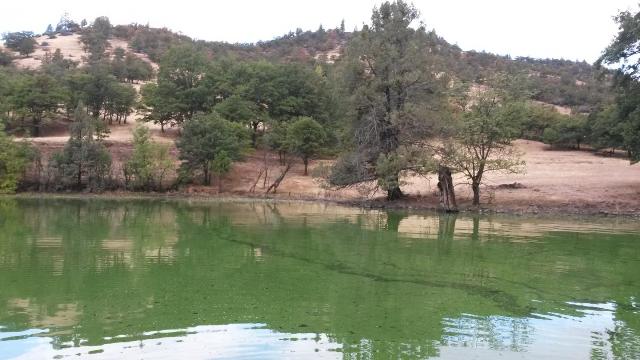 This algal bloom on the Copco Reservoir on the Klamath River can be transported downstream and cause health risks to people and wildlife. Credit: Oregon State University
This algal bloom on the Copco Reservoir on the Klamath River can be transported downstream and cause health risks to people and wildlife. Credit: Oregon State University
A research team from Oregon State University has discovered that reservoirs on the Klamath River contain harmful algal blooms that are capable of travelling over 180 miles along the lower parts of the river in just a matter of days.
These blooms are unaffected while travelling via hydroelectric turbines and ultimately lead to unsafe water conditions downriver in northern California.
According to the research team, a large number of water-borne algal blooms can pose health hazards to humans, animals and wildlife, alike. As a result, public health outreach and improved monitoring are required to resolve this problem.
The duration, frequency, and extent of toxic algal blooms seem to be growing significantly. The researchers discovered this trend based on the information obtained from the Klamath River survey conducted in 2012. The findings have been published in a professional journal, Harmful Algae.
If toxins are bio-accumulated in certain animal species, they could pose a major problem. For instance, in freshwater mussels, the level of the toxin can be many times higher than ambient concentrations.
It's clear that these harmful algal blooms can travel long distances on the river, delivering toxins to areas that are presently underappreciated, such as coastal margins.
And the blooms are dynamic, since they can move up and down in the water column and are physically distributed throughout the reservoir. This means you can't just measure water in one place and at one time and adequately estimate the public health risk.
Timothy Otten
OSU Postdoctoral Scholar
OSU College of Science and College of Agricultural Sciences
Microcystis, a form of seasonal blue-green cyanobacterium, can be found across the globe. This bacterium prefers warm waters in reservoirs and lakes. Some strains of these species are harmful, while others are not.
According to the researchers, global climate change will further encourage the magnitude and perseverance of these species which would lead to a number of health issues such as rashes, liver damage, and gastrointestinal illness, to name a few. It is not possible to destroy the toxin by boiling and this makes Microcystis different from many other biological contaminants present in drinking water.
According to the OSU research team, better awareness of the blooms’ ability to travel considerable distances in the lower parts of the river and communication based on that awareness would aid in informing the public in a better way. Individual understanding and awareness could also help in resolving this issue.
On a lake or river, if you see a green band along the shore or green scum on the surface, the water may not be safe to recreate in. Because this problem is so diffuse, it's often not possible to put up posters or signs everywhere that there's a problem in real-time, so people need to learn what to watch for.
Just as with poison ivy or oak, the general public needs to learn to recognize what these hazards look like, and know to avoid them in order to safeguard their own health.
Timothy Otten
OSU Postdoctoral Scholar
OSU College of Science and College of Agricultural Sciences
"Right now, some lakes are not sampled at all for algal blooms, so we don't really know if there's a problem or not. There's no doubt we could use improved monitoring in highly used lakes and reservoirs, or in rivers downstream of them when toxic blooms are found," said Theo Dreher, the Pernot Professor and former chair of the Department of Microbiology in the OSU College of Science and College of Agricultural Sciences.
In addition to this new research, the OSU researchers also carried out a different study in which they created genetic tools. Such tools can provide a faster and more affordable solution for detecting issues related to Microcystis when compared to other traditional methods. However, till date, these tools have not been extensively implemented by the monitoring community.
In the latest study, the OSU scientists discovered that the Iron Gate Reservoir on the Klamath River contain large concentrations of Microcystis blooms, which were the main source of harmful algae seen downstream. They utilized genetic tracking technology to ascertain what many would have assumed when viewing Microcystis populations in the lower parts of the Klamath River. This passage of algae was not widely researched, although it is probably widespread.
According to the researchers, one way to reduce this issue would be the removal of reservoirs on the Klamath River after the year 2020. The research revealed no evidence of prevalent populations of Microcystis in the flowing parts of the Klamath River, both downstream and upstream of the Iron Gate and Copco reservoirs. Particularly in summer, the issue with these toxin-producing cyanobacteria is both a national and global concern.
Over 123,000 lakes measuring more than 10 acres in size are spread across the US. According to an EPA National Lakes Assessment, one-third of lakes may contain cyanobacteria. This problem is further increased by dams, extreme weather conditions, rising atmospheric carbon dioxide concentrations and temperatures, and increased overflow of nutrients from agricultural and urban lands.
Each year, a large number of eutrophic lakes, such as Lake Erie, are contaminated with large concentrations of toxic algal blooms, which can be seen even from the outer space. Consumption of contaminated water has contributed to the death of dogs and sea otters in Monterey Bay on account of eating shellfish that was contaminated with Microsystis-produced toxin.
The OSU Agricultural Experiment Station, Pacificorp and the Mabel E. Pernot Trust supported the study.